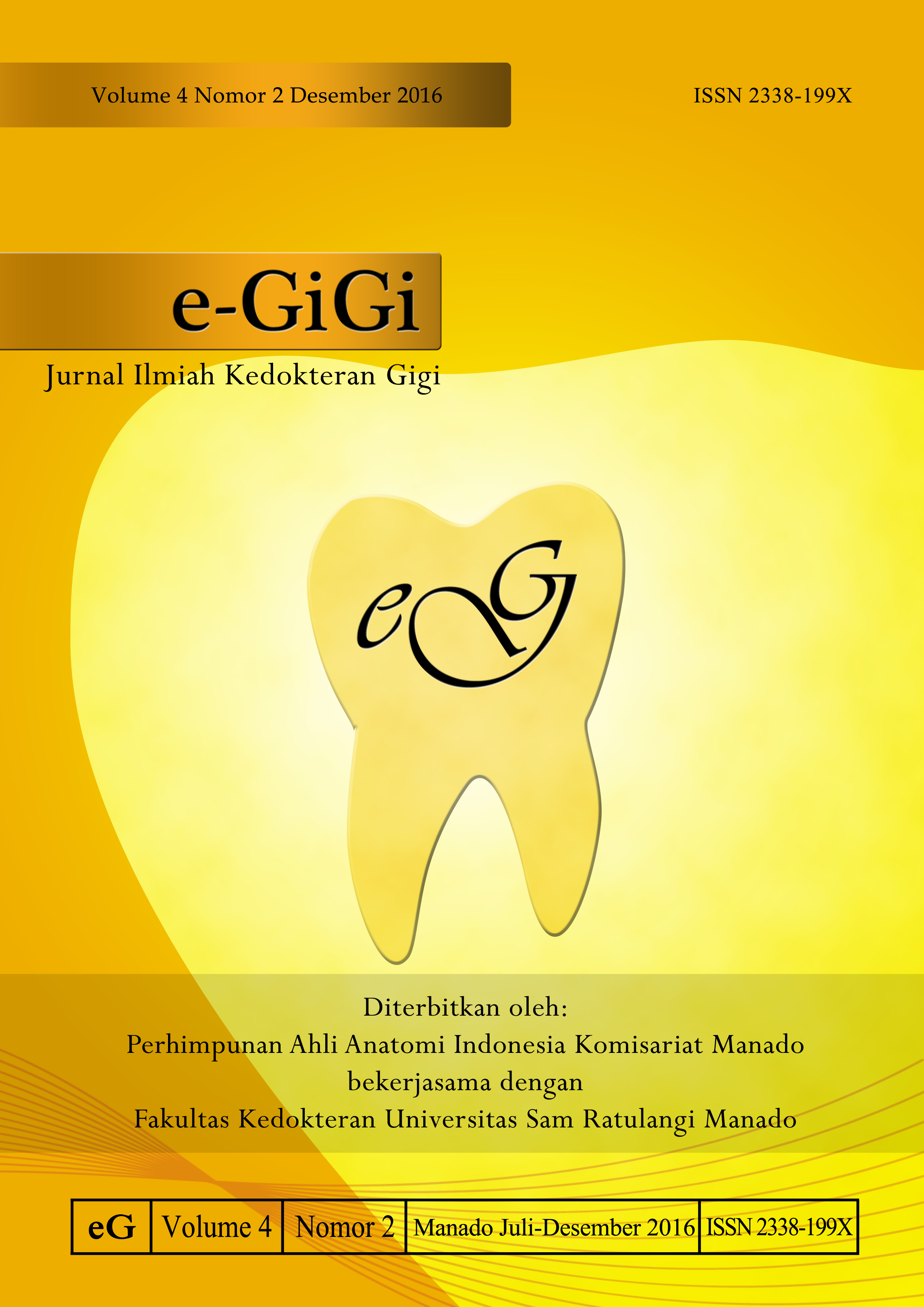Pengaruh berkumur larutan teh hijau dalam menurunkan akumulasi plak pada gigi anak usia 8-10 tahun
DOI:
https://doi.org/10.35790/eg.4.2.2016.13925Abstract
Abstract: Oral health is still a major problem in Indonesia. Ignorance towards oral health has lead to accumulation of dental plaques. Children aged 8-10 are susceptible to have dental caries because they like to consume rich-sugar foods. Moreeover, these children are in the process of teeth changes and the growth of new teeth. There are many methods to prevent plaque forming besides tooth brushing inter alia oral rinsing which can cover wider surfaces of the oral cavity. This study was aimed to determine the effect of oral rinsing with green tea solution on reducing dental plaque accumulation among children aged 8-10 years. This was a quasi-experimental study with a pre-test and post-test group design. Population of study was students of SDN 126 Manado aged 8-10 years old. Samples were obtained by using total sampling method. There were 32 participants divided into two groups: rinsing with green tea solution and rinsing with 0.2% chlorhexidine solution (control group). The paired t-test stated that the accumulation of plaque was decreased after rinsing with green tea solution significantly (p=0.001). Meanwhile, the t-independent test on green tea solution and chlorhexidine had different scores in reducing plaque accumulation (p=0.004). Conclusion: Oral rinsing with green tea solution could reduce plaque accumulation in students aged 8-10 years, however, the mean reduction of plaque accumulation after rinsing with green tea solution was less than after rinsing with 0.2% chlorhexidine solution.
Keywords: dental plaque, green tea
Â
Abstrak: Masalah kesehatan gigi dan mulut masih menjadi perhatian di Indonesia. Salah satu penyebab ialah terabaikannya kesehatan gigi dan mulut yang mengakibatkan timbulnya akumulasi plak pada gigi. Usia 8-10 tahun sangat rentan terhadap karies karena anak senang mengonsumsi makanan yang mengandung gula. Pada usia ini diperlukan perawatan lebih intensif karena terjadi pergantian gigi dan tumbuhnya gigi baru. Pendekatan pencegahan yang dikenal selain menyikat gigi ialah dengan berkumur yang mencapai lebih banyak permukaan rongga mulut, sehingga efektivitas kontrol plak meningkat. Penelitian ini bertujuan untuk mengetahui pengaruh berkumur dengan larutan teh hijau dalam menurunkan akumulasi plak pada gigi anak berusia 8-10 tahun. Jenis penelitian ialah kuasi-eksperimental dengan pre-test dan post-test group design. Metode pengambilan sampel ialah total sampling Populasi penelitian ialah siswa SDN 126 Manado berusia 8-10 tahun dengan 32 orang responden yang dibagi menjadi dua kelompok yaitu kelompok perlakuan dengan larutan teh hijau, dan kelompok kontrol dengan chlorhexidine 0,2%.. Uji t-paired menyatakan antara sebelum dan sesudah berkumur larutan teh hijau terjadi penurunan akumulasi plak yang bermakna (p=0,001). Berdasarkan uji t-independent larutan teh hijau dan chlorhexidine memiliki penurunan akumulasi plak yang berbeda (p=0,004). Simpulan: Larutan teh hijau dapat menurunkan akumulasi plak pada siswa berusia 8-10 tahun. Rerata penurunan akumulasi plak gigi berkumur dengan larutan teh hijau lebih kecil daripada berkumur dengan chlorhexidine 0,2%.
Kata kunci: plak gigi, teh hijau
Downloads
Published
How to Cite
Issue
Section
License
COPYRIGHT
Authors who publish with this journal agree to the following terms:
Authors hold their copyright and grant this journal the privilege of first publication, with the work simultaneously licensed under a Creative Commons Attribution License that permits others to impart the work with an acknowledgment of the work's origin and initial publication by this journal.
Authors can enter into separate or additional contractual arrangements for the non-exclusive distribution of the journal's published version of the work (for example, post it to an institutional repository or publish it in a book), with an acknowledgment of its underlying publication in this journal.
Authors are permitted and encouraged to post their work online (for example, in institutional repositories or on their website) as it can lead to productive exchanges, as well as earlier and greater citation of the published work (See The Effect of Open Access).






